By Mike Smith
“ How hard did he work to get that ball?” I often times find myself asking my players this right after they have just sent the ball up the field to break pressure, not understanding immediately giving the ball back to the opponent actually CREATES pressure. Many times it is the opposing center backs who simply find the ball rolling right their way with ample time and space to continue applying attacking pressure. To help with this, I often break from the standard 4-4-2 defensive set up ( as shown below ) and basically run my two forwards in a “ hi / low” pattern. I hesitate to simply designate it hi/low because I don’t want the forward players isolated, so instead I focus on making sure one of them is always in position to disrupt the opposing side’s center backs.
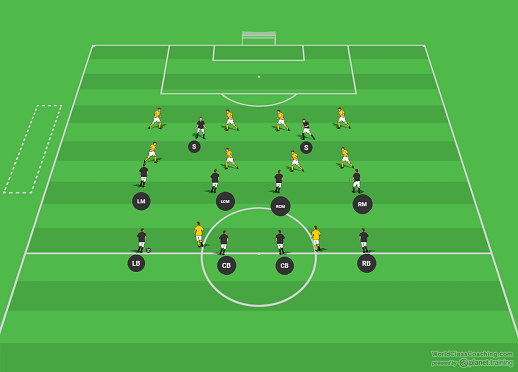
In the diagram below, our focus will be on the defending ( yellow) team. Note the position of the defending team’s high forward ( shaded ). IF this player drops in too far, or pressures the ball along with the other forward ( who should always pressure back when possession is lost to an opposing defender ) then the easy switch is there for the attacking team AND they will be able to establish themselves across the width of the field. When a team does this, it often times makes the field too big to defend and leads to a guaranteed service into the box.
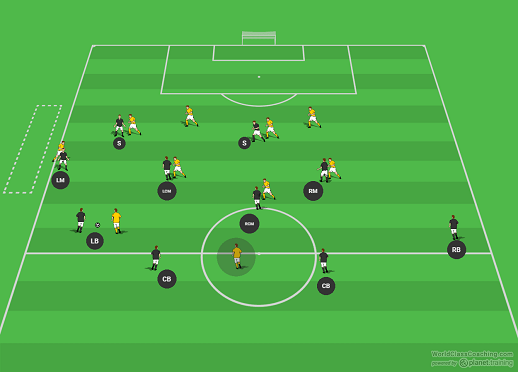
The diagram below shows the attempt by the attacking team to make the field big. However, IF one of the defending team’s forwards can prevent the connection from being made using the center backs, the defending team can make the attack very predictable and thus, preventable.
Again below, the defending team has dropped into to a basic 4-4-2 defending shape. The attacker with the ball does have a wide outlet in the left mid, however an experienced team will easily shift out and pinch this type of attack out wide on the line, wit out exposing the central areas of the field. With the defending forward up disrupting, the attacking team can be baited into the long switch and the defending midfielders have a great shot at the ball ( as shown ). This attempt at the ball would traditionally come from the other defending forward and is often won. However, when the forward wins the ball, with only another marked forward as a target and 3 additional defenders closing down or in front, the options for a quick, numbers up counter are few. IF a MIDFIELDER can win the ball ( as shown below ) a quick 3 v 3 or 3 v 2 attack is a viable option, all because one forward stayed up and central.
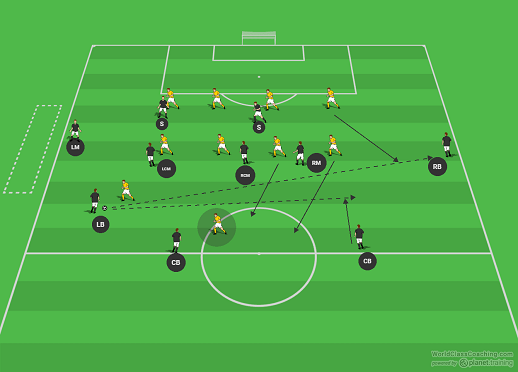
Here are a couple drills which will help put this concept into use for your team.
Lesson 1
3 v 1 Cut Off
Set Up
Set up a 15 yd wide by 10 yd long box as shown. One defender works against one attacker inside the box. There are two additional attackers on the outside of the box, one on each long side ( as shown ). Play starts when one outside attacker sends the ball into the attacker in the box. This attacker is attempting to pass the ball to the remaining attacker on the other side of the box. IF the pass cannot be made, the central attacker should pass back to the starting attacker and another attempt should be made. The defending player is attempting to cut off the switch. The focus should be on making the attacker pass the ball back out to the attacker who started the play. Players can switch after each successful connection or after a certain number of attempts.
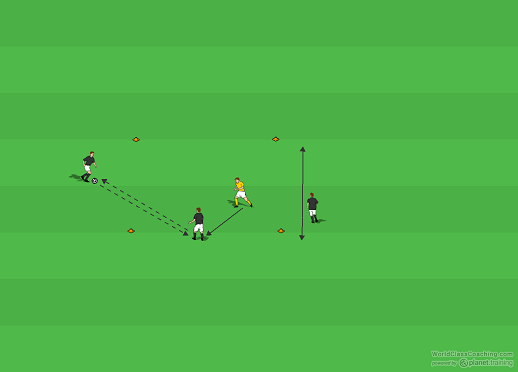
Coaching Points
The focus is on the defending player, who isn’t really concerned with winning the ball, but rather with controlling the space the ball must travel through and the positioning of the attacker in possession of the ball. The defender should attempt to close down and prevent the attacker from turning at all. However, as the attacker passes back out, the defender has to drop off a bit and cut off the space before stepping back in to pressure. The coach should reinforce this here.
Lesson 2
Keep Them Isolated
Set Up
Divide a half field in half with cones as shown. 6 attackers, 2 target players ( red ) plus a keeper attempt to score on 5 defenders. Place two stick goals on the half line, one on each side ( as shown ). There are 3 attackers, two defenders and 1 neutral in each section and players must stay in their section the entire time. Play starts with the keeper passing out to a wide attacker, who must combine with the neutral on their side, who combines with the neutral on the other side to set up a score. Goals for the attacking team can only be scored on the opposite side from where play started and neutrals can not score. The goal is for the central defender ( actually the forward in a match ) to challenge the two neutrals and prevent the connection.
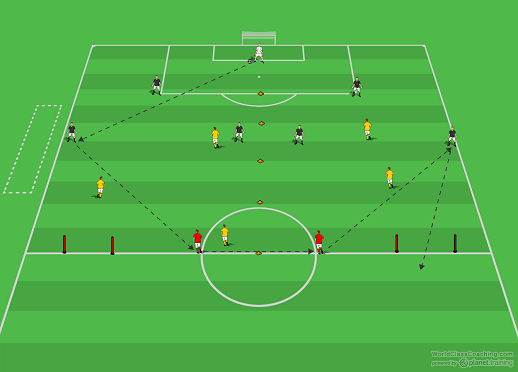
Coaching Points
Even though this looks like a 9 v 5 on paper, IF the central player for the defending team can prevent the connection, play becomes a 3 v 3. The coach should focus on the central defender, who will actually be a forward player in a match, and stress the importance of disrupting the neutrals or center backs in an actual game.
By Mike Smith
Currently the Head Coach for University Heights Academy Boys Soccer in Hopkinsville, KY , Mike is in his 14th year as a high school head coach with 23 years coaching experience overall and 34 year as a student and fan of the game. He holds a USSF D License.


